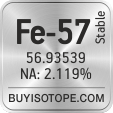Fe-57 Isotope Applications:
Iron-57 isotope (Fe-57 isotope, 57Fe isotope)
- Fe-57 isotope is used for studies of fibre sorbents, Ziegler–Natta catalysts, polynuclear cluster compounds;
- Fe-57 isotope is used for doping of iron borate crystals for studies of nuclear resonant scattering ;
- Fe-57 isotope is used for research of studies of phase transfer kinetics in minerals and cation exchange in hydrothermal processes;
- Fe-57 isotope is used for studies of irregularities in structures of crystals, glass and ceramic materials through nuclear gamma resonance (NGR) and electron paramagnetic resonance (EPR);
- Fe-57 isotope is used for studies of iron metabolism, protein tracing through NGR spectroscopy;
- Fe-57 isotope is used for as an absorber for Mössbauer spectrometer calibration;
- Fe-57 isotope is used for gamma radiation detector development;
- Fe-57 isotope is used for magnetic domain thin film design;
- Fe-57 isotope is used for studies of hydrogen diffusion in metals;
- Fe-57 isotope is used for studies of magnetic compounds (e.g. studies of materials with high Curie temperatures and electron mobility, magnetic semiconductors, magnetic isotope doped amorphous materials);
- Fe-57 isotope is used for studies of phase changes and pinhole defects in rare-earth metal oxides;
- Fe-57 isotope is used for studies of surface properties of high dispersion minerals;
Fe-57 isotope is available to order from BuyIsotope.com in Fe-57 metal (Fe) chemical form and in Fe-57 oxide (Fe2O3) chemical form. Please contact us via request a Fe-57 quote BuyIsotope.com to order Fe-57 isotope, to get Fe-57 price and to buy Fe-57 isotope.
Fe-57 Safety Data Sheet (SDS) in metal form - Download pdf file
Download Fe-57 SDS in metal form
Fe-57 Safety Data Sheet (SDS) in oxide form - Download pdf file
Download Fe-57 SDS in oxide form
Properties of Fe-57 Isotope:
| Properties of Fe-57 Isotope: | Fe-57 |
|---|---|
| Natural Abundance (%) | 2.12 |
| Atomic Mass (Da) | 56.9353928 |
| Relative Isotopic Mass | 56.9353928 |
| Neutron Number (N) | 31 |
| Atomic Number (Z) | 26 |
| Mass Number (A) | 57 |
| Nucleon Number (A) | 57 |
| Proton Number (Z) | 26 |
| Half-life | Stable |
| Spin | 0.5 |
| Quadrupole Moment | 0 |
| g-factor (g value) | 0.1809 |
| Group | 8 |
| Period | 4 |
| Electron Configuration Block | d |
| Melting Point (K) | 1811 |
| Boiling Point (K) | 3034 |
| Specific Heat | 0.412 |
| Heat of Formation | 415.5 |
| Thermal Conductivity | 80.4 |
| Dipole Polarizability | 62 |
| Electron Affinity (kJ/mole) | 0.153236 |
| Electronegativity (Pauling scale) | 1.83 |
| Atomic Radius (pm) | 126 |
| Covalent Radius (pm) | 140 |
| VDW Radius (pm) | ― |
| Lattice Constant | 2.856 |
| Crystal Structure | BCC |
| Jmol color | #e06633 |
Fe-57 Information
Iron is a silvery malleable and ductile metallic transition element. It has 28 isotopes, 4 of them are natural stable ones, and it is the fourth most abundant element in the earth's crust. Iron is required by living organisms as a trace element (it is used in hemoglobin in humans). Quite reactive, iron oxidizes in moist air, displaces hydrogen from dilute acids and combines with nonmetallic elements.
Iron is used in steel and other alloys. This element is essential for humans. Iron is the chief constituent of hemoglobin which carries oxygen in blood vessels. Its oxides are used in magnetic tapes and disks.
FAQ about Fe-57 Isotope:
What is Fe-57 isotope natural abundance?
Answer: 2.120 %
What is atomic mass for Fe-57 isotope?
Answer: 56.935393 Da
What is isotopic mass for Fe-57 isotope?
Answer: 56.935393
How many neutrons does Fe-57 isotope have?
Answer: 31
How many protons does Fe-57 isotope have?
Answer: 26
How many electrons does Fe-57 isotope have?
Answer: 26
What is atomic number for Fe-57 isotope?
Answer: 26
Is Fe-57 isotope stable?
Answer: Yes
Is Fe-57 isotope radioactive?
Answer: No

